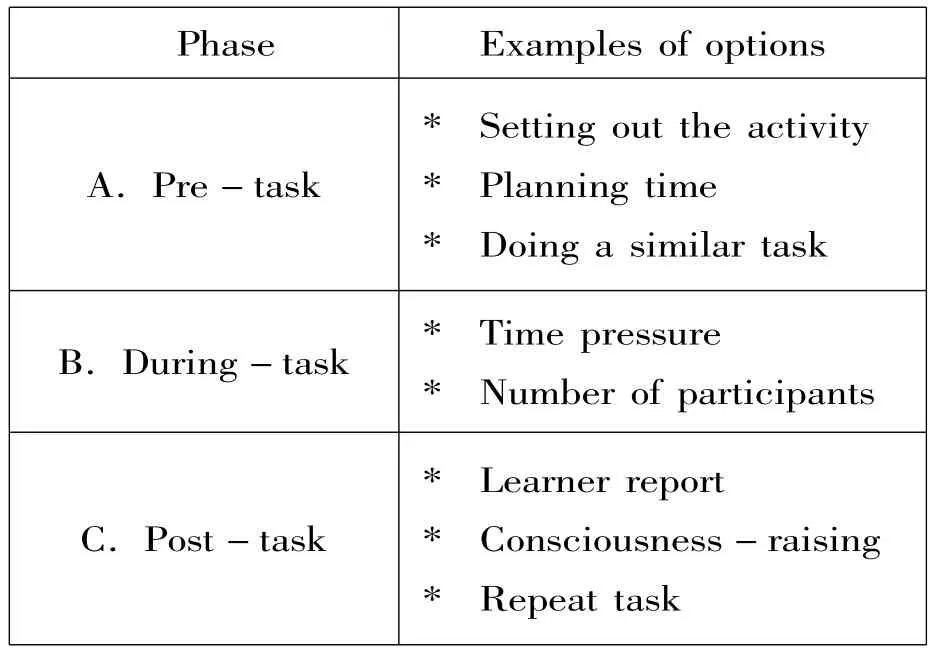Task-Based Approach in Language Teaching
王 坚
I.Introduction
Task-based language teaching is derived from Dewey’s attitude about the crucial role of experience for an effective learning.It considers the functional role of language in real tasks as the major goal for students to communicate at the class for an ideal learning.Unlike traditional form -based approaches,task-based involves the specification of a sequence of interactive tasks to be performed in the target language rather than a sequence of language items.Language teaching has been affected by many changes for the last few decades.Many methods have been introduced.Teachers experienced Audio Lingual Method,Total Physical Response(TPR),Natural Approach,and many other methods.It is generally believed that there is no single method that can meet the students’needs.
II.Definitions of“Task”
Task is defined in different ways.Long(1985)defines it as“a piece of work undertaken for oneself or for others,freely or for some reward.Thus,examples of tasks include painting a fence,dressing a child,filling out a form,buying a pair of shoes.In other words,by‘task’is meant the hundred and one things people do in everyday life,at work,at play,and in between”(p.89).Nunan(2004)made a distinction between target tasks and pedagogical tasks.According to him,target tasks refer to language use in the world beyond the classroom.Pedagogical tasks,on the other hand,refer to language use that occurs in the classroom.The word“task”has broader meaning.It sometimes refers to“metacommunicative tasks”,or other exercises by focusing on language form,where learners use language or make generalizations about it.As a result,these definitions are non-technical and non-linguistic.Furthermore,some of the examples that are provided may not include language use at all.Therefore,each task can be part of a larger sequence of tasks,for example,the task of class activities for a teacher may be a part of the task to give“final scores”.
Pedagogical task in Breen’s view is defined as“any structured language learning endeavor which has a particular objective,appropriate content,a specified working procedure,and a range of outcomes for those who undertake the task”.“Task”is therefore assumed to refer to a range of work plans which have the overall purposes of facilitating language learning-from the simple and brief exercise type,to more complex and lengthy activities such as group problem-solving or simulations and decision-making.(Breen,1987,p.23)
But even this definition is not accurate because everything that the learner does in the classroom is considered as a task.Then Willis(1996,p.173)gave another definition about it as“…where the target language is used by the learner for a communicative purpose(goal)in order to achieve an outcome”.Here the notion of meaning is subsumed in“outcome”.Language in a communicative task is seen as bringing about an outcome through the exchange of meanings.
III.Task-based features
Major characteristics of task-based approach are outlined as:
√Task as a reflection of real world activity
√Task as the syllabus unit
√Task as a learner-centered base
√Task as an ideal for second language acquisition condition
√Task as an instrument to specify the parts to be concentrated in the next activities
The first characteristic,task as a reflection of real world activity,is similar for all models of this approach.According to Breen(1987),tasks are defined as social and problem -solving interaction.The second feature,task as the syllabus unit,is more difficult than the first one,since new syllabuses do not involve a single method to identify the subject of any course but usually include several ways to deal with different features of the course.The third feature,task as a learner-centered base,is regarded as a general characteristic for this approach by Breen and Nunan.Nunan supported increased learner-centered base.His views were relevant to task - based approach.The fourth point,task as an ideal for second language acquisition condition,was the base of Long and Crookes’s model to task-based approach.They claimed that this model is based on a second language acquisition project,on a classroom -oriented research,and on the bases of syllabus and course design.The last feature,task as an instrument to specify the parts to be concentrated in the next activities,directly indicates the role for tasks in a cycle.However,different ways to select the type of tasks have been offered.Long outlined four steps for developing a taskbased syllabus:(1)Set a need analysis program to get target tasks.(2)Sort out the target tasks into separate task types.(3)Set pedagogical tasks based on the task type.(4)Choose pedagogical tasks and put them in order to form a task syllabus.
IV.Task-based approach in language teaching
One evident outcome of this approach is the exchange of information in spoken or written language.Therefore teachers can ask learners to exchange and perform instructions,or to solve a problem,or to tell the story for their partners.In all of these activities,we are looking for one goal which is making students independent of the language to achieve that goal.One of the major features of task-based approach is that learners who perform a task are free to use any kind of language to achieve their outcome,in other words,language forms are not determined in advance.Learners never take note of language inputs to produce them.As soon as they decide to apply language for purposeful communications,they try to find appropriate input to make new meanings.In fact,they are not willing to reproduce a series of language forms in target norms.Their purpose is to create a meaning system by which they will be able to operate rapidly and efficiently in real time.As a result,in order to achieve this goal,they will apply and expand language forms that they have been recently faced with,but they will also adopt some sorts of strategies that lead them to ignore grammatical nuance points and to make forms which are not prohibited by the target norms.Therefore,the purpose of a communicative task is to motivate learners to create a meaning system.But different learners use different strategies and different language forms to fulfill the goal.The design of a task -based oriented course includes paying attention to the steps or components of a lesson that has a task in its principals.Different designs have offered.However all of them have three phases in common which are illustrated in the following table.These phases are represented in a taskbased lesson chronologically.

Table:A framework for designing task-based lessons(Willis,1996)
As can be seen from the table,the first phase is called“pre-task”that concerns with different ac-tivities that both teachers and students undertake before they start the task,and the activities involve giving students time to plan for the performance of the task.In the second phase,that is called“during-task”phase,the focus is on the task itself and it provides different pedagogical options,like identifying students’needs to perform during a specific time.The last phase is called“post-task”and it includes procedures to follow-up the given task.In task based teaching“during-task”is the only compulsory phase.So,items that are selected from the“pre-task”or“post-task”phases are optional.
V.Summary
The more task-based approach is studied,the more necessity for sequencing of activities is observed.The controversial topic is to present a sequencing theme without any prevention in the learner’s linguistic knowledge and his ability to get himself involved in the learning process.Therefore,teachers can apply a variety of communicative language teaching methodologies that consist of the best ways of teaching.
[1]Allwright,D.Why don’t learners learn what teachers teach?The interaction hypothesis.In D.Singleton and D.Little(eds.).Language Learning in Formal and Informal Contexts(p.3-18),Dublin:IRAL.1984.
[2]Breen,M..Learner contributions to task design.In C.Candlin and D.Murphy(Eds.),Language Learning Tasks.Englewood Cliffs NJ:Prentice-Hall1987.
[3]Ellis,R..Task-based language learning and teaching.Oxford:Oxford University Press.2002.
[4]Long,Michael H.“A Role for Instruction in Second Language Acquisition:Task-Based Language Training.” Modeling and Assessing Second Language Acquisition.Ed.Kenneth Hyltenstam and Manfred Pienemann.Clevedon:Multilingual Matters,1985,p.77 -99.
[5]Nunan,D..The learner- centered curriculum.Cambridge University Press: New York.1988.
[6] Skehan,P.A framework for the implementation of task-based instruction.Applied Linguistics.1996.
[7]Skehan,P.A cognitive approach to language learning.Oxford:Oxford University Press.1998.
[8] Willis,D..A Framework for Task - Based Learning.London:Longman.1996.

